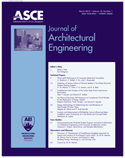Design Methodology for Determining the Load Resistance of Heat-Treated Window Glass
Publication: Journal of Architectural Engineering
Volume 18, Issue 1
Abstract
ASTM E 1300-07 employs only two glass type factors to adjust the load resistance of annealed glass for heat treatment, one factor for heat-strengthened glass and one factor for tempered glass. The use of only two factors provides a simplistic approach that fails to utilize the full capacity of heat-treated glass. ASTM E 1300-07 differentiates heat-strengthened from fully tempered glass by the magnitude of the residual compressive surface stress resulting from the heat treating process. Furthermore, ranges of residual compressive surface stress are specified for both heat-strengthened and fully tempered glasses, suggesting the glass type factors should vary with the residual compressive surface stress. This article presents a rational method for determining the load resistance of heat-treated glass based on the residual compressive surface stress. A method incorporating previously accepted design principles with the addition of extensive data computation is advanced to calculate load resistance for heat-treated glass. With the new method including the use of 25 additional charts, designers can easily design heat-treated glass based on any value of residual compressive surface stress.
Get full access to this article
View all available purchase options and get full access to this article.
References
ASTM. (1989). “Standard practice for determining the minimum thickness of annealed glass required to resist a specified load.” ASTM E 1300-89, West Conshohocken, PA.
ASTM. (1994). “Standard practice for determining the minimum thickness and type of glass required to resist a specified load.” ASTM E 1300-94, West Conshohocken, PA.
ASTM. (2004). “Standard specification for heat-treated flat glass-kind heat strengthened, kind fully tempered coated and uncoated glass.” ASTM C 1048-04, West Conshohocken, PA.
ASTM. (2007). “Standard practice for determining the load resistance of glass in buildings.” ASTM E 1300-07, West Conshohocken, PA.
Beason, W. L., and Morgan, J. R. (1984). “Glass failure prediction model.” Struct. Eng., 110(2), 197–212.
Bowles, R., and Sugarman, B. (1962). “The strength and deflection characteristics of large rectangular glass panels under uniform pressure.” Glass Technol., 5(3), 156–170.
Brown, W. G. (1974). “A practicable formulation for the strength of glass and its special application to large plates.” NRCC 14372, National Council of Canada, Division of Building Research, Ottawa, Canada.
Building Officials Code Administration International (BOCA). (1965). National Building Code, 4th Ed, Homewood, IL.
Charles, R. J. (1958). “Static fatigue of glass. I.” J. Appl. Phys., 29(11), 1549–1553.
Griffith, A. A. (1920). “The phenomena of rupture and flow in solids.” Philos. Trans. R. Soc. A, CCXXI(A587), 163–179.
International Conference of Building Officials (ICBO). (1967). Uniform Building Code, Whittier, CA.
Norville, H. S., Bove, P. M., Sheridan, D. L., and Lawrence, S. L. (1993). “Strength of new heat treated window glass lites and laminated glass units.” Struct. Eng., 119(3), 891–901.
Oakes (1991). “The development of design factors for heat-strengthened and tempered glass based on the glass failure prediction model.” Master’s thesis, Texas A&M Univ., College Station, TX.
Orr, L. E. (1957). “Engineering properties of glass.” Windows and glass in the exterior of buildings, Pub. 478, Building Research Unit, U.S. National Academy of Sciences, Washington, DC, 51–62.
Redner, A. S., Mognato, E., and Schiavonato, M. (2005). “Correlation between strength and measured residual stress in tempered glass products.” J. ASTM Int., 2(3).
Southern Building Code Congress International (SBCCI). (1962). “Standard building code.” Birmingham, AL.
Vallabhan, C. V. G., and Wang, B. Y-T. (1981). Nonlinear analysis of rectangular glass plates by finite difference method, NTIS Accession No. PB84-159649, Institute For Disaster Research, Texas Tech Univ., Lubbock, TX.
Weibull, W. (1939). “A statistical theory of the strength of materials.” Handlinger NR 151, Ingeniörsvetenskapsakademiens Royal Technical Univ., Stockholm, Sweden.
Information & Authors
Information
Published In
Copyright
© 2012 American Society of Civil Engineers.
History
Received: Jan 26, 2010
Accepted: May 19, 2011
Published online: May 21, 2011
Published in print: Mar 1, 2012
Authors
Metrics & Citations
Metrics
Citations
Download citation
If you have the appropriate software installed, you can download article citation data to the citation manager of your choice. Simply select your manager software from the list below and click Download.
